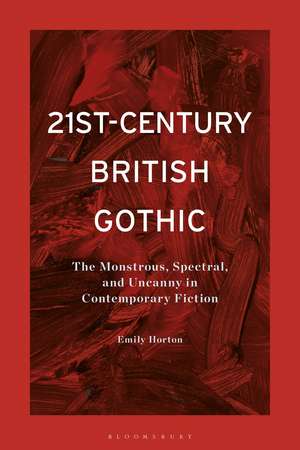21st-Century British Gothic: The Monstrous, Spectral, and Uncanny in Contemporary Fiction
Autor Emily Hortonen Limba Engleză Hardback – 21 feb 2024
Preț: 511.48 lei
Preț vechi: 731.81 lei
-30% Nou
Puncte Express: 767
Preț estimativ în valută:
97.88€ • 101.12$ • 81.46£
97.88€ • 101.12$ • 81.46£
Carte tipărită la comandă
Livrare economică 25 martie-08 aprilie
Preluare comenzi: 021 569.72.76
Specificații
ISBN-13: 9781350286566
ISBN-10: 1350286567
Pagini: 272
Dimensiuni: 156 x 234 mm
Greutate: 0.56 kg
Editura: Bloomsbury Publishing
Colecția Bloomsbury Academic
Locul publicării:London, United Kingdom
ISBN-10: 1350286567
Pagini: 272
Dimensiuni: 156 x 234 mm
Greutate: 0.56 kg
Editura: Bloomsbury Publishing
Colecția Bloomsbury Academic
Locul publicării:London, United Kingdom
Caracteristici
Reads Gothic tropes in the works of Pat Barker, Ali Smith, Trezza Azzopardi, Hari Kunzru, Nadeem Aslam, Mohsin Hamid, China Mieville, Kazuo Ishiguro, Helen Oyeyemi, Brian Chikwava, and John Burnside against key contemporary events that have increased global instability such as 9/11, the Iraq War, financial crisis, ecological disaster and Brexit
Notă biografică
Emily Horton is Senior Lecturer in English at Brunel University, UK. She is author of Contemporary Crisis Fictions (2014), and co-editor of Ali Smith (Bloomsbury, 2013), The 1980s: A Decade in Contemporary British Fiction, (Bloomsbury, 2014)The 2010s: A Decade in Contemporary British Fiction (Bloomsbury, 2024).
Cuprins
INTRODUCTION: 21st-Century British Gothic: The Monstrous, Spectral, and Uncanny in Contemporary FictionCHAPTER 1: Post-9/11 Gothic: The Uncanny and Contemporary Trauma in Pat Barker's Double Vision and Patrick McGrath's Ghost TownCHAPTER 2: Decolonial Gothic: Tropical Terrors and Subterranean Ghosts in Tash Aw's The Harmony Silk Factory and Nadeem Aslam's The Wasted VigilCHAPTER 3: Gothic Inheritance: Imperial Witchcraft and Haunted Houses in Helen Oyeyemi's White is for Witching and Sarah Waters' The Little StrangerCHAPTER 4: Digital Gothic: Digital Technology, Migration, and the Gothic in Hari Kunzru's Transmission and Mohsin Hamid's Exit WestCHAPTER 5: Gothic Homelessness: Spectral Inhabitants and Uncanny Spaces in Ali Smith's Hotel World, Trezza Azzopardi's Remember Me, and Brian Chikwava's Harare NorthCHAPTER 6: The Gothic City: Uncanny spaces, historical spectres, and monstrous urbanity in Louise Welsh's The Cutting Room and Chloe Aridjis's Book of CloudsCHAPTER 7: Brexit Gothic: Spectral Illusions and Affect Memories in Sarah Moss's Ghost Wall and Niall Griffith's Broken GhostCHAPTER 8: Pandemic Gothic: Childhood Terror and Monstrous Illness in the Fiction of Kazuo Ishiguro and M.R. CareyCHAPTER 9: Wet Gothic: Ecofeminism and Horror in Julie Armfield's Our Wives Under the Sea, Daisy Johnson's Fen, and Zoe Gilbert's FolkBibliographyIndex
Recenzii
Incisive, richly informed and beautifully written, this book is a major contribution to Gothic studies. It will be essential reading for anyone wanting to deepen their understanding of new directions in Gothic fiction in the twenty-first century. Highly recommended.
